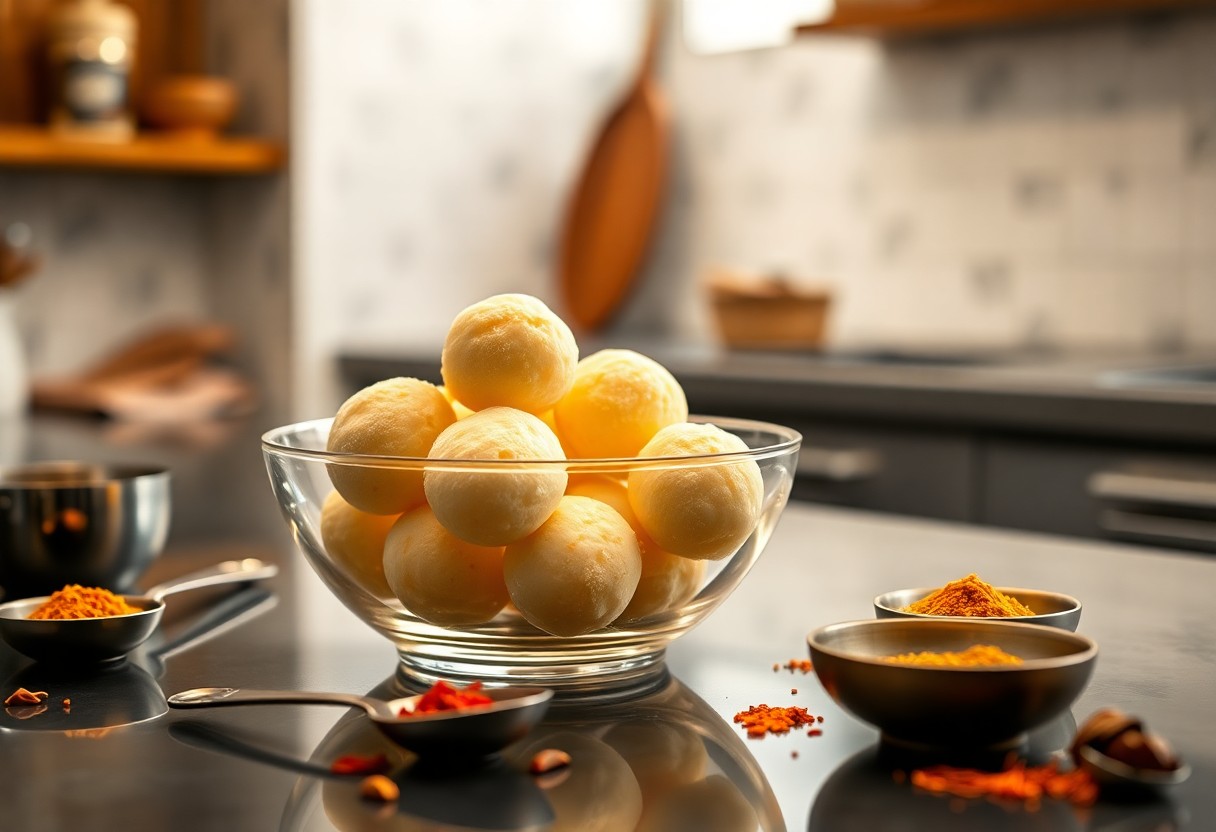Authenticity in Indian sweets hinges on one key element: 100% desi ghee. As you explore the rich tapestry of Indian desserts, you’ll discover that this ghee not only enhances flavor but also contributes to the unique texture and aroma that define these delicacies. By incorporating desi ghee in your recipes, you elevate the sweet experience, connecting with traditional culinary practices. This blog post investigates into the significance of desi ghee, revealing its role in crafting the most beloved Indian confections.
The Origins of Desi Ghee
Desi ghee’s roots trace back over 5,000 years, evolving from age-old traditions in the Indian subcontinent. Its production initially stemmed from the need to preserve milk, making it a staple in both culinary and medicinal practices. As you explore the cultural significance of ghee, you’ll see how it has transcended its role as an ingredient to become a revered element of Indian hospitality and spirituality.
Historical Significance
The historical significance of desi ghee is immense, finding its place in ancient texts such as the Vedas and Ayurveda, where it is celebrated for its health benefits and use in rituals. In many households, ghee represents prosperity and purity, often utilized during festivals and ceremonies, enhancing the flavors of traditional sweets like laddus and barfis.
Traditional Methods of Production
Traditional production of desi ghee involves the painstaking process of hand-churning curd to extract butter, which is then simmered to separate the milk solids and water. This method not only preserves the rich flavors but also maintains the nutritional qualities inherent in the butterfat, resulting in a distinct taste that mass-produced alternatives cannot replicate. In rural areas, this time-honored technique often involves the entire community, reflecting the cultural bond shared over food.
The Role of Ghee in Indian Cuisine
Ghee plays an integral part in Indian cuisine, transcending its role as a mere cooking fat. Its unique properties allow it to withstand high temperatures while imparting a rich, aromatic quality to dishes. From sautéing spices to enriching dals and curries, ghee enhances the overall culinary experience, unlocking deeper flavors and harmonizing ingredients.
Flavor Enhancement
Your dishes attain a profound depth when ghee is involved. The nutty aroma and buttery taste elevate both sweet and savory items, making every bite more satisfying. Whether it’s the lavishly prepared biryanis or creamy halwas, ghee acts as a flavor carrier, intensifying spices and complementing sweeteners brilliantly.
Nutritional Benefits
Incorporating ghee into your diet offers notable health advantages, including improved digestion and enhanced nutrient absorption. Packed with imperative fatty acids, vitamins A, D, E, and K, ghee supports overall wellness while promoting heart health and providing a source of concentrated energy.
Choosing 100% desi ghee means prioritizing quality and nutritional integrity. Unlike processed oils, ghee contains butyrate, a short-chain fatty acid linked to anti-inflammatory properties. This fatty acid aids in gut health by promoting good bacteria and also enhances vitamin absorption, making your Indian sweets not just delicious but beneficial. The conjugated linoleic acid present in ghee can also support weight management and metabolic health, making it a functional choice in your culinary endeavors.
Characteristics of Authentic Indian Sweets
Authentic Indian sweets are characterized by their rich flavors, intricate textures, and vibrant colors. Each delicacy tells a story of regional heritage and culinary traditions, whether it’s the syrup-soaked softness of gulab jamun or the flaky layers of baklava. The balance of sweetness, taste, and aroma creates a unique experience, inviting you to indulge in the harmony of spices, nuts, and milk products that define these confections.
Key Ingredients
Your journey into authentic Indian sweets begins with key ingredients like khoya, jaggery, and, of course, 100% desi ghee. Khoya, a concentrated form of milk, brings creaminess and richness, while jaggery adds a deep, caramel-like sweetness. Desi ghee, with its distinctive flavor, enhances these ingredients, imparting depth and complexity, making them imperative to achieving the authenticity you seek.
The Influence of Ghee on Texture and Taste
Ghee is more than just an ingredient; it’s the backbone of texture and flavor in Indian sweets. This golden elixir infuses richness that transforms the overall eating experience. You will notice how ghee imparts a luxurious mouthfeel, allowing sweets like barfi and peda to melt effortlessly. Its unique aroma elevates even the simplest recipes, creating a satisfying depth that other fats struggle to achieve.
Ghee not only enhances the flavor profile but also plays a pivotal role in the texture of sweets. When used in frying, it ensures a perfect crispness on the outside while maintaining a soft, tender core. Consider traditional sweets such as laddoos and halwas; the incorporation of ghee leads to a buttery, smooth consistency that feels indulgent yet familiar. The toasty notes of ghee, combined with the other ingredients, create a harmonious blend that captures the essence of Indian sweets, making each bite an experience to savor.
Popular Indian Sweets Made with Desi Ghee
Indian sweets crafted with 100% desi ghee elevate the culinary experience, infusing rich flavors and unparalleled creaminess. Each traditional delicacy showcases ghee’s ability to enhance taste and texture, making it an crucial element in iconic desserts. From festive celebrations to everyday treats, these sweets are a testament to culinary artistry, with regional variations offering a diverse array of choices for indulgence.
Gulab Jamun
Gulab Jamun, a beloved dessert, consists of small, deep-fried dough balls made from khoya, soaked in fragrant sugar syrup. This classic sweet derives its luxurious flavor from the generous use of desi ghee during preparation, creating a melt-in-your-mouth texture that transports you to a world of indulgence. The aromatic elements of cardamom combined with the glossy finish from ghee make this dessert a festival favorite.
Barfi
Barfi is a versatile sweet that comes in various flavors, often made with condensed milk and sugar. When prepared with desi ghee, barfi achieves a creamy consistency and rich flavor that is hard to resist. You can find barfi in flavors like pistachio, coconut, and chocolate, each lending its own charm while the ghee ties together the ingredients beautifully. Not only does it enhance the sweetness, but ghee also imparts a distinct nuttiness, making each piece a flavorful delight.
The Cultural Importance of Sweets in Indian Festivals
Sweets hold a revered place in Indian festivals, symbolizing joy, prosperity, and togetherness. Each celebration is incomplete without a variety of traditional pastries and confections that bring families and communities together. They serve not only as treats but also as offerings in rituals, emphasizing their integral role in spiritual and social gatherings.
Celebratory Traditions
You’ll find that every Indian festival features its signature sweets, each with a story deeply rooted in tradition. For Diwali, for instance, the preparation of laddoos and barfis ignites joy in homes, while during Eid, sewaiyaan sets the festive mood. Sharing these delicacies with family and friends enhances the spirit of celebration, creating lasting memories.
Regional Variations
The diversity of India reflects in the sweets prepared across different regions, each boasting unique flavors and techniques. For instance, Punjab is known for its rich, dairy-based sweets like kulfi, while Bengal is famous for its soft and syrupy rasgullas. These variations not only highlight regional ingredients but also local cultural influences, showcasing the richness of Indian culinary heritage.

Modern Adaptations and Trends
Traditional Indian sweets continue to evolve, incorporating modern techniques and flavors that cater to contemporary tastes. Chefs and home bakers alike experiment with unique ingredients and presentation styles, infusing global influences while maintaining the essence of Indian sweets. Whether you encounter vegan variants or desserts inspired by world cuisines, these adaptations reflect a growing desire for versatility without sacrificing authenticity.
Health-Conscious Approaches
With a rising emphasis on health, many are reimagining Indian sweets by omitting refined sugars and incorporating natural sweeteners like dates or jaggery. Other innovative alternatives include gluten-free flours and the use of fruits, which provide distinct flavors while enhancing nutritional value. This shift allows you to indulge guilt-free, marrying taste with health consciousness.
Fusion Sweets
Fusion sweets blend traditional Indian flavors with international culinary elements, creating exciting new treats. Think of a mango cheesecake infused with saffron or a chocolate barfi featuring matcha. These innovative concoctions not only surprise your palate but also pay homage to global food trends, making them appealing to a broader audience.
Fusion sweets have gained popularity by harmonizing distinct flavor profiles, marrying elements such as chocolate with cardamom or coconut with lavender. The rise of artisanal dessert shops often showcases these offerings, breaking barriers between cultures while introducing you to novel taste experiences. For example, “Lassi Popsicles” have become a celebrated summer treat in many urban spaces, combining the flavors of traditional lassi with a frozen twist. These imaginative variations are perfect for those looking to explore and enjoy sweets outside their conventional boundaries.
Conclusion
With these considerations, you can see how 100% desi ghee plays a vital role in defining authentic Indian sweets. Its unique flavor, aroma, and health benefits elevate traditional recipes and create a rich sensory experience. By choosing sweets made with pure desi ghee, you ensure that each bite honors the culinary heritage of India, enhancing your appreciation for these beloved treats. Embrace this secret ingredient, and you’ll truly taste the difference in your desserts.

